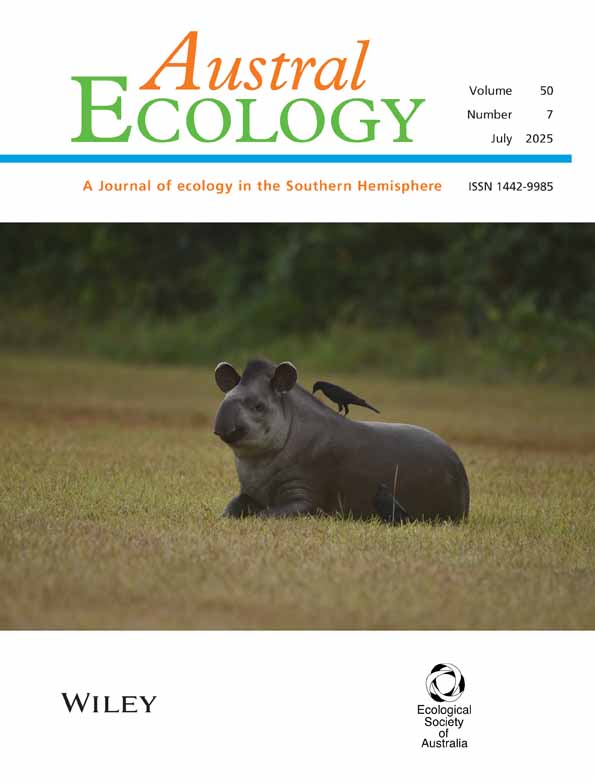Book Reviews: 2
Monitoring Plant and Animal Populations
C. L. Elzinga, D. W. Salzer, J. W. Willoughby and J. P. Gibbs. Blackwell Science, Malden, MA, 2001, 360 pages. Price AUD$151.95. ISBN 0 632 04442 X.
This easy-to-read manual would be a valuable reference for anyone who manages or monitors fauna or flora populations. It includes a lot of basic information that would be extremely useful for students with limited field experience but it is also an encyclopaedic reference with much technical information that would be useful to experienced land managers. The information included ranges from what to take on a field trip and options for marking out field sites, to a discussion of statistical techniques for identifying trends in data. The clear message of this book is that objectives need to be clearly defined and that the gathering of information about populations needs to be integrated with management responses.
The first chapter defines monitoring and the philosophy of the book. Monitoring needs to integrate information-gathering with clear management objectives and responses. The authors recognize that management generally relies on limited observational data rather than controlled, well-replicated experimental data. The authors of this book are land managers, who discuss many management issues that are not covered by other books on population biology. Reasons for the success and failure of monitoring programs are discussed. Chapter 2 breaks down the monitoring process into a series of stages. The first of these is the collection of background data on the species and on the resources available. Next, objectives are developed through the use of ecological models and by defining management aims and responses. Existing or altered management of the population is then implemented. The monitoring methodology is designed, tested, implemented and evaluated. Results are then reported and used to assess management practices. Chapter 3 discusses the setting of priorities, including the identification of international, national and local priorities. It discusses the selection of species, allocation of resources and determining the scale and intensity of monitoring efforts.
Chapter 4 discusses qualitative techniques for monitoring. It gives guidelines for determining a range of qualitative information about a population, including presence/absence, population abundance, population condition, site condition and population mapping. The use of photopoints, videography and remote sensing techniques are discussed. Chapter 5 then goes into general field techniques in detail. Field equipment and the identification/location of field plots are discussed in detail with a wide range of options discussed to deal with differing circumstances. The need for secondary information to identify plot boundaries and good record-keeping is emphasized and should be a ‘must read’ for every student about to commence field work involving the use of permanent sites. Just reading the ‘field hints’ section could also save much time and frustration. For example, minimizing the potential for vandalism of permanent marking points is discussed. Chapter 6 discusses data collection and data management.
Prior to undertaking quantitative field studies, an understanding of sampling design and statistical analysis of data is required. Chapters 7 and 8 discuss the basic principles of sampling and sampling design. Five approaches and equations to determine appropriate sample sizes are presented in appendix 2. Chapter 9 introduces statistical analysis and the analysis of trends in data is explored in more detail in Chapter 10. Appendix 3 discusses the determination of confidence intervals for simple sampling designs in more detail. Appendix 4 then presents techniques to determine sample size and confidence intervals for more complex sampling designs. Chapter 11 discusses random sampling. In these chapters, sufficient information is provided to understand and use the procedures confidently in most situations, with checks for common problems.
Field measurement techniques are presented in the next two chapters. Chapter 12 discusses field techniques for quantitative measurements of vegetation and chapter 13 discusses sampling and measurement techniques for animals. Appendix 1 briefly introduces some of the changes and challenges to be considered in order to monitor communities rather than populations. The last two chapters discuss the setting of objectives and the communication of monitoring plans. My only criticism of the book is that some of the abbreviations and terms such as ‘ORV’ should have been included in a glossary, particularly because some of the terms may not be familiar to non-US readers. I would recommend this book to anyone responsible for managing flora and fauna populations or students who are commencing population-focused field studies at a postgraduate level. SEAN BELLAIRS Faculty of Science, Information Technology and Education Northern Territory University Darwin, Northern Territory, Australia




